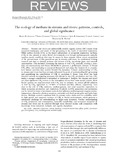| dc.contributor.author | Stanley, Emily H. | |
| dc.contributor.author | Casson, Nora J. | |
| dc.contributor.author | Christel, Samuel T. | |
| dc.contributor.author | Crawford, John T. | |
| dc.contributor.author | Loken, Luke C. | |
| dc.contributor.author | Oliver, Samantha K. | |
| dc.date.accessioned | 2018-09-25T22:41:56Z | |
| dc.date.available | 2018-09-25T22:41:56Z | |
| dc.date.issued | 2015-12-07 | |
| dc.identifier.citation | Stanley, Emily H., Nora J. Casson, Samuel T. Christel, John T. Crawford, Luke C. Loken, and Samantha K. Oliver. "The ecology of methane in streams and rivers: patterns, controls, and global significance." Ecological Monographs 86(2) (2016):146-171. DOI: 10.1890/15-1027. | en_US |
| dc.identifier.issn | 0012-9615 | |
| dc.identifier.uri | http://hdl.handle.net/10680/1574 | |
| dc.description.abstract | Streams and rivers can substantially modify organic carbon (OC) inputs from terrestrial landscapes, and much of this processing is the result of microbial respiration. While carbon dioxide (CO₂) is the major end‐product of ecosystem respiration, methane (CH₄) is also present in many fluvial environments even though methanogenesis typically requires anoxic conditions that may be scarce in these systems. Given recent recognition of the pervasiveness of this greenhouse gas in streams and rivers, we synthesized existing research and data to identify patterns and drivers of CH₄, knowledge gaps, and research opportunities. This included examining the history of lotic CH4 research, creating a database of concentrations and fluxes (MethDB) to generate a global‐scale estimate of fluvial CH₄ efflux, and developing a conceptual framework and using this framework to consider how human activities may modify fluvial CH₄ dynamics. Current understanding of CH₄ in streams and rivers has been strongly influenced by goals of understanding OC processing and quantifying the contribution of CH₄ to ecosystem C fluxes. Less effort has been directed towards investigating processes that dictate in situ CH₄ production and loss. CH₄ makes a meager contribution to watershed or landscape C budgets, but streams and rivers are often significant CH₄ sources to the atmosphere across these same spatial extents. Most fluvial systems are supersaturated with CH₄ and we estimate an annual global emission of 26.8 Tg CH₄, equivalent to ~15‐40% of wetland and lake effluxes, respectively. Less clear is the role of CH₄ oxidation, methanogenesis, and total anaerobic respiration to whole ecosystem production and respiration. Controls on CH₄ generation and persistence can be viewed in terms of proximate controls that influence methanogenesis (organic matter, temperature, alternative electron acceptors, nutrients) and distal geomorphic and hydrologic drivers. Multiple controls combined with its extreme redox status and low solubility result in high spatial and temporal variance of CH₄ in fluvial environments, which presents a substantial challenge for understanding its larger‐scale dynamics. Further understanding of CH₄ production and consumption, anaerobic metabolism, and ecosystem energetics in streams and rivers can be achieved through more directed studies and comparison with knowledge from terrestrial, wetland, and aquatic disciplines. | en_US |
| dc.description.sponsorship | "Support for this paper was provided by funding from the North Temperate Lakes LTER program, NSF DEB‐0822700." | en_US |
| dc.description.uri | https://esajournals.onlinelibrary.wiley.com/doi/full/10.1890/15-1027 | en_US |
| dc.language.iso | en | en_US |
| dc.publisher | Ecological Society of America | en_US |
| dc.rights | info:eu-repo/semantics/openAccess | |
| dc.subject | Anaerobic Respiration | en_US |
| dc.subject | Carbon | en_US |
| dc.subject | Database | en_US |
| dc.subject | Ecosystem Metabolism | en_US |
| dc.subject | Efflux | en_US |
| dc.subject | Global | en_US |
| dc.subject | Greenhouse Gas | en_US |
| dc.subject | Heterogeneity | en_US |
| dc.subject | Lotic | en_US |
| dc.subject | Methanogenesis | en_US |
| dc.subject | Methanotrophy | en_US |
| dc.title | The ecology of methane in streams and rivers: patterns, controls, and global significance | en_US |
| dc.type | Article | en_US |
| dc.identifier.doi | 10.1890/15-1027 | en_US |

